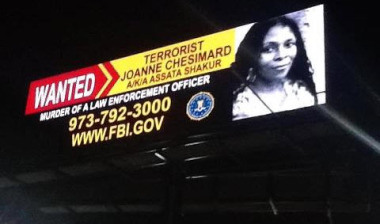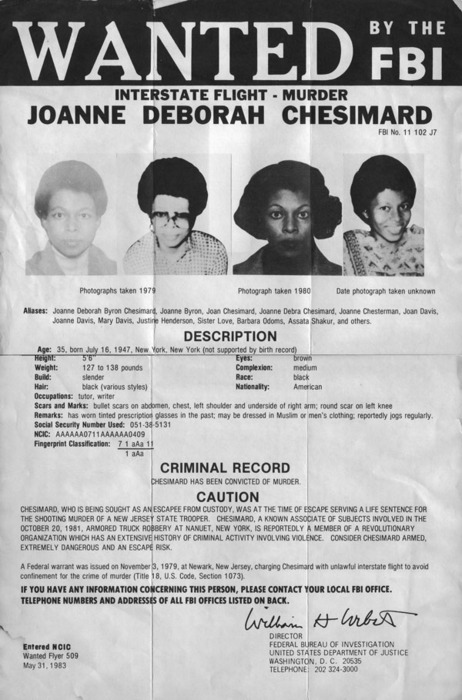by Barry Sheppard
May 6, 2013
In the aftermath of the bombing of the Boston Marathon, the Obama administration is broadening its definition of “terrorism” to include fighters for Black rights in the U.S.

Washington has already used the term so indiscriminately against its opponents internationally that it has become virtually meaningless. For example, every act of resistance to U.S. occupation in Iraq and Afghanistan is labeled “terrorism.”
By that definition, George Washington and the other American revolutionists were “terrorists” for resisting British occupation.
On May 2, the Department of Justice chose this moment of confusion and fear generated by the Boston bombing to place exiled former Black Panther Assata Shakur on the FBI’s “Most Wanted Terrorists” list.
This is the same list Osama bin Laden was on. When the announcement was made, it included a bounty of $2 million on her head.
“It is an open invitation, not only with respect to the United States government, but for anyone, in Cuba or elsewhere, to become a vigilante, to go there and to not only apprehend and bring her back, or to kill her,” said Lennox Hinds, Shakur’s lawyer in the U.S.
There is no right to appeal being placed on the Most Wanted Terrorists list.
Assata Shakur has been living in Cuba since 1979, a political refugee, having been granted asylum by the Cuban government on the grounds that she faced prosecution based on her political beliefs and race.
At first glance, this seems quite bizarre. Shakur’s alleged act of “terrorism” occurred forty years ago. Why dredge this case up now, with the sensationalism of placing her on the Most Wanted Terrorists list? Shakur was charged with murder in that incident.
The famous Black activist, professor and author Angela Davis, who faced a similar charge of murder in 1970, and was finally acquitted after a massive international defense campaign, had this to say:
“It was a major shock to hear that Assata Shakur has become the first woman to be added to the FBI’s Most Wanted Terrorists list….It seems to me that this act incorporates or reflects the very logic of [the war on] terrorism. I can’t help but think that it’s designed to frighten people who are involved in struggles today,” around “police violence, healthcare, education, people in prison, and so forth.”
Hinds and Davis were interviewed on “Democracy Now!”
In its statement, the Department of Justice said that Shakur was not only a terrorist 40 years ago, but remains so today, organizing terrorist acts against the U.S. from exile in Cuba. This is so absurd it is mind-boggling. Not one shred of evidence was given or asserted that over the past 30 years she has been involved in any movements or organizations plotting terrorist acts against the U.S.
At he May 2 news conference, FBI agent Aaron T. Ford said she was put on the list because she “is a supreme terror [sic] against the government who continues to give speeches espousing revolution and terrorism” from her exile in Cuba.
Ford is lying. In none of her speeches has Shakur advocated terrorism, and he gave no evidence of any such.
What she has done is to continue to promote her political beliefs. “There’s always this slippage between what should be protected free speech – that is to say, the advocacy of revolution, the advocacy of radical change – and what the FBI represents as terrorism,” Davis said.

“You know, certainly, Assata continues to advocate radical transformation of this country, as many of us do. I continue to say that we need revolutionary change. This is why it seems to me that the attack on her reflects the logic of [the war on] terrorism, because it is precisely designed to frighten young people who would be involved in the kind of activism that might lead to change.”
Until this latest statement by the Department of Justice, Assata Shakur was never charged with “terrorism.” She was convicted of murder in 1977 in a frame-up trial resulting from an incident that occurred in 1973. The word “terrorism” was never mentioned at her trial.
To understand the original charges against Shakur, we have to recall the political atmosphere of the Black liberation struggle of the 1960s and early 1970s, and the war waged against it by the FBI and police.
The head of the FBI at the time, the notorious anti-communist and racist J. Edgar Hoover initiated COINTEL, a program of disruption and frameup of the antiwar and Black movements, as well as socialists. Concerning the Black movement, all Black organizations were under attack, from the Black Panthers, the Southern Christian Leadership Conference of Martin Luther King, the National Association for the Advancement of Colored People, the Nation of Islam whose most powerful spokesman was Malcolm X, to everything in between.
Hoover issued a directive that the rise of a ”Black messiah” had to be crushed, and made reference to King and Malcolm X. A “Mau Mau uprising” had to be thwarted, a reference to the liberation movement that occurred in Kenya.
The FBI and police departments waged an especially murderous campaign against the Black Panthers and its offshoots, killing and framing up many.
Joanne Cheismard had first joined the Black Panthers, and changed her name to Assata Shakur when she then became part of the Black Liberation Army.
In 1973, Shakur was traveling in a car with other BLA members on the New Jersey Turnpike, when they were targeted by state police and pulled over. The police opened fire, and shot Shakur in the back.
In the ensuing gun battle, a state trooper was killed, as was a BLA member.
A surviving BLA member was convicted of the killing of the trooper, and remains in prison.
At her trial, it was claimed that Shakur had taken the trooper’s gun and shot him. This assertion couldn’t hold up. Her lawyer, Lennox Hinds, who took her case and has been fighting to have her exonerated since, recalls, “If we look at the trial, we’ll find that she was victimized, she was shot. She was shot in the back. The bullet exited and broke her clavicle in her shoulder. She could not raise a gun in her hand to shoot.
“And she was shot while her hands were in the air. Now, that is the forsensic evidence. There is not one scintilla of evidence placing a gun in her hand. No gun shot residue was found on her clothing or on her hands.”
So she was not convicted of being the actual shooter. Nevertheless, at the May 2 news conference, the FBI resurrected this charge, falsely claiming it was proven.

Shakur was convicted of being an accomplice because she was in the car, and therefore was convicted of murder by an all-white jury in the inflamed atmosphere of the times.
Shakur nearly died of her wounds. Imprisoned, she was tried and convicted in 1977. In 1979 she escaped, and through an underground railroad that other political prisoners took made her way to Cuba.
In addition to equating advocacy of revolution to “terrorism,” the government has another objective in putting Shakur on the Most Wanted Terrorists list. They want to bolster their long-standing designation of Cuba as a “terrorist state.”
Hinds, who is a professor of criminal justice at Rutgers University in New Jersey, said, “Cuba is accused of harboring terrorists.…[But] the United States government and the CIA have encouraged, trained, sent individuals to not only disrupt the Cuban economy by killing tourists, placing bombs in restaurants and hotels, and to assassinate Fidel Castro, and individuals who admitted that they were involved in the downing of a Cuban airliner in 1973.
“I’m talking about Posada Carriles. Here was a man who made the open admission [of the airliner bombing], trained by the CIA, harbored by the United States. When he was found in the United States, did the United States prosecute him for his crimes? No. They, on a pretext, prosecuted him for lying to the FBI. And acquitted him of that.”
